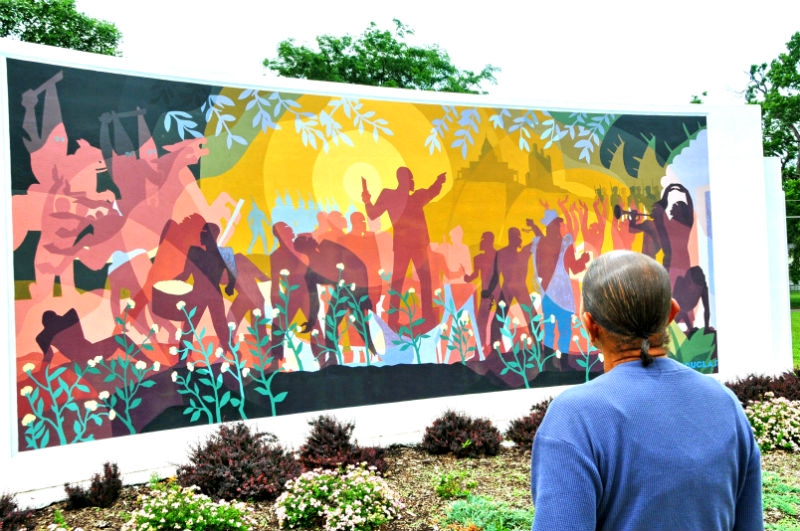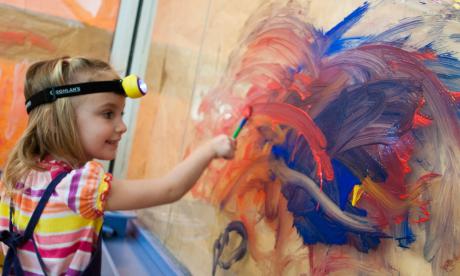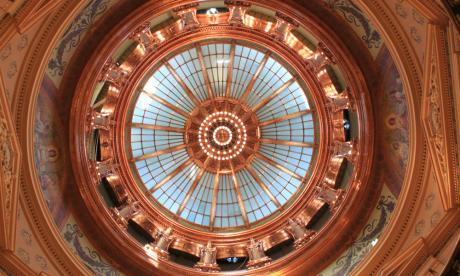
The painter and illustrator, Aaron Douglas, called the painting above From Slavery to Reconstruction. This was one mural in his four-part series and probably most-known work, Aspects of Negro Life. Also included in this were the paintings Song of Towers, An Idyll of the Deep South, and The Negro in an African Setting. But today, I’m going to focus on From Slavery to Reconstruction, the piece that introduced me to Douglas, that is displayed somewhat covertly in the middle of town, and that I stumbled upon in an unsuspecting neighborhood standing tall with grandiosity.
ALSO READ:The Impactful Messages Found in Brown V. Mural
I pride myself on trying to get to know whatever place I live, its idiosyncrasies and quirks, so when I was driving a new route through town, listening to the usual, circa-1987 Suzanne Vega and passed a park that I’d never heard of, I was perplexed. Aaron Douglas Park? How did I not know this existed? Is this a neighborhood mural that isn’t meant for an outsider’s gaze? Should I be averting my eyes from the beauty? Also, who is Aaron Douglas, why are copies of his art in Topeka and why should I care? Thus, began the investigation.
Douglas grew up in Topeka, Kansas- a native Topekan, and came of age at a time just after the Civil War, a time when African Americans had the technicalities of freedom but were still very much held captive by the mistreatment and hatred of many of their peers. Douglas suffered the injustices that so many African Americans did at the time, but he found a way through it, art. From a young age he was creating; his mother introduced him to watercolors and he was hooked. By his early 20s, Douglas was a reasonably accomplished artist with dreams of making it to Paris and changing the world with his art, which brings us back to this piece.
Learn about Topeka's ties to Civil Rights History.
Aspects of a Negro Life was created long after Douglas’ time in Topeka, long after Douglas made his indelible mark in the Harlem Renaissance, long after Douglas became known as the father of Black American art. This was created during his time as a professor at Fisk University just after accomplishing his dream of living and studying in Paris, but it embodied everything he ever wanted to say as an artist. From Slavery to Reconstruction takes the viewer on a journey through slavery, emancipation and the rebirth of African traditions. From the picking of cotton on the left of the mural to the Emancipation Proclamation in the center to the music and freedom portrayed on the right, Douglas walks the viewer through the emergence of Black America. Moreover, what makes Douglas’ work special is that he was the first to introduce traditional African roots into his art. He famously wrote a letter to Langston Hughes saying, "Your problem dear Langston, my problem, no our problem is to conceive, develop, establish an art era. Not white art painted black." And that’s exactly what Douglas did.
But my mind still raced as to why this painting? The entire series is extraordinary, so how is just one picked to display? What qualifies one mural to rise above the others? The answer, in my opinion, comes down to hope.
Explore the many murals of Topeka.
While the other three paintings have a colder feel to them using primarily blues and greens, From Slavery to Reconstruction is orange and yellow and warmth. The other three look to the razor-sharp reality of African American heritage, while From Slavery to Reconstruction calls attention to the African American experience with a hopeful edge while admonishing racism. There is a hope in this piece that isn’t as prevalent in the others.
From stumbling upon the mural and the park, I didn’t know the nuance that Douglas put into this piece, how he learned so much of the style exemplified in it from his time in Paris or that he was at the forefront of the Harlem Renaissance. I didn’t know he grew up in Topeka or is known as the father of Black American art, but anyone can look and see the story, the revolution, and the hope that the mural represents. Not white art painted black, but an era, a new age of art that celebrates the singularity of the African American culture
This mural and the park in general serve as a reminder that we are still growing and learning, that we have come very far as a society, but still have a long way to go. Aaron Douglas grew up in a time before the civil rights movement, a time before Brown V Board rocked Topeka and the country. While so much has changed for the better, Douglas’ mural reminds us that we should always be growing toward good and celebrating the singularities and diversity that we so luckily have in our society. So, if you’re ever strolling through central and want to see an extremely positive part of Topeka history, I would check out Aaron Douglas Park.









